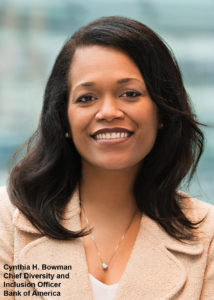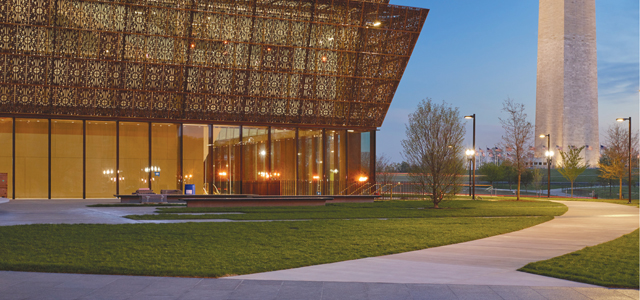At Bank of America, we know that the power of diversity, truly harnessing our differences — in thought, style, culture, ethnicity, sexual orientation, gender identity and expression, and experience – is what makes any culture strong, and company successful.
In a recent study on Global Human Capital Trends, Deloitte notes “leading organizations now see diversity and inclusion as a comprehensive strategy woven into every aspect of the talent life cycle to enhance employee engagement, improve brand and drive performance.”
Investing in the Difference Maker
Our disciplined approach to continuing to improve our diversity, is driven by our Global Diversity and Inclusion Council (GDIC), which has been chaired for the last 10 years by our CEO, Brian Moynihan. The group is comprised of senior business leaders and provides strategic direction on diversity and inclusion by setting priorities, driving progress and helping make an impact on the issues that matter most to our employees.
We see the results in our workforce and leadership: more than 50% of our global workforce is female and more than 40% of our
U.S. workforce is racially or ethnically diverse. Our senior leader- ship is equally diverse, with six of our CEO’s 12 direct reports and six of our 13 independent Board of Director members being female and/or persons of color.
Each member of our management team, including the CEO, has diversity and inclusion metrics incorporated into their business goals, and that focus is expected for all managers across the company, as well. In fact, each of our lines of business have councils charged with planning and implementing diversity strategies and meeting their targeted goals and metrics. To support these efforts, we partner with more than 200 schools, colleges, universities, and external organizations to recruit qualified diverse candidates. In fact, our most recent campus recruiting class was more than 50 percent diverse.
Developing Leaders for the Future

Key to ensuring the success of diversity and inclusion efforts is developing leaders who reflect the make-up of an employee base and the communities in which we live and work. Our Employee Networks provide employees with opportunities to connect, develop leadership skills, build strong ties with their communities, broaden their view of diversity and address issues that matter to them. We have 11 Employee Networks with more than 240 chapters made up of more than 93,000 members worldwide.
Our Black Professional Group (BPG) is one of our oldest Employee Networks and has more than 10,000 members in chapters across the U.S. BPG supports the recruitment, retention and promotion of black employees, offers mentoring to help develop leadership potential, and sponsors regular networking and events.
In 2012, we established the Black Executive Leadership Council, a group committed to supporting the advancement and increasing representation of Black/African American talent at Bank of America. Its 150 members advocate for and sponsor strong performers, help grow talent, and connect and engage to build relationships and expand networks.
Further, our Diverse Leaders Sponsorship Program provides diverse talent (protégés) with senior leaders (sponsors) to proactively identify and promote the visibility of diverse talent for the purpose of increasing representation and building robust diverse talent pipelines.
Most importantly, leadership and integrated team members at all levels are provided a platform to celebrate and grow from our differences, and to openly address and discuss challenges that we face.
Courageous Conversations and Critical Moments
The importance of dialogue, transparency and tolerance throughout the diverse communities at Bank of America is recognized throughout our offices in more than 35 countries around the world. It is ingrained in our culture and has positioned us to sup- port employees and respond to issues that matter to them.
“We each have power, and a role in driving diversity and inclusion,”said Cynthia Bowman, Bank of America’s Chief Diversity and Inclusion Officer, to employees who had gathered in Charlotte, NC.
“Inclusion is about everyone. We need to explore it, celebrate it, talk about it. Speak up and say something. Our stories need to collectively be told and understood.”
In 2016, at least a dozen conversations happened across the company, impacting nearly 60,000 employees. In one such conversation in December, we welcomed members from our National Community Advisory Council (NCAC) for a conversation about social justice and racial equality. Our NCAC brings together independent community leaders, representing leading organizations across the U.S. in the areas of civil rights, consumer advocacy and environmental policy. Panelists included Cornell Brooks of
the NAACP, Wade Henderson of the Leadership Conference on Civil and Human Rights, and Marc Morial of the National Urban League. It was broadcast to more than 50,000 Employee Network members and replays were shared with all employees
We continue to encourage courageous conversations with our employees and community partners, which make clear our unwavering commitment to diversity and inclusion and provide space and support for employees to understand and learn from each other.
Expansion to Community, Arts and Culture
Our efforts to promote diversity and inclusion don’t stop at our doorway. We know that diversity does more than strengthen companies like ours. It strengthens entire communities and economies. That’s why we tie company initiatives back to the communities we represent. By supporting our local communities, arts and culture, partnering with advocate
groups and organizations and reinvesting in economic mobility, we’re able to keep a finger on the pulse of true issues facing our employees and customers.
We are proud to be a Founding Member of the Smithsonian National Museum of African American History and Culture, granting more than $5 million including sponsorship of the museum’s opening events.
And since 2014, we’ve invested nearly $14 million in organizations that support the Black/African-American community, including $1 million in education, more than $11 million to civil rights and advocacy organizations and more than $2.5 million to promote and preserve arts and culture.
“Diversity and inclusion is about more than employees and numbers. We believe that investing in the communities we serve helps drive sustainable economic growth and has a long-term, positive effect for all of us, ”said Bowman.“Being a diverse and inclusive organization is critical to our mission of responsible growth and building a company that people want to work for, invest in and do business with.”



